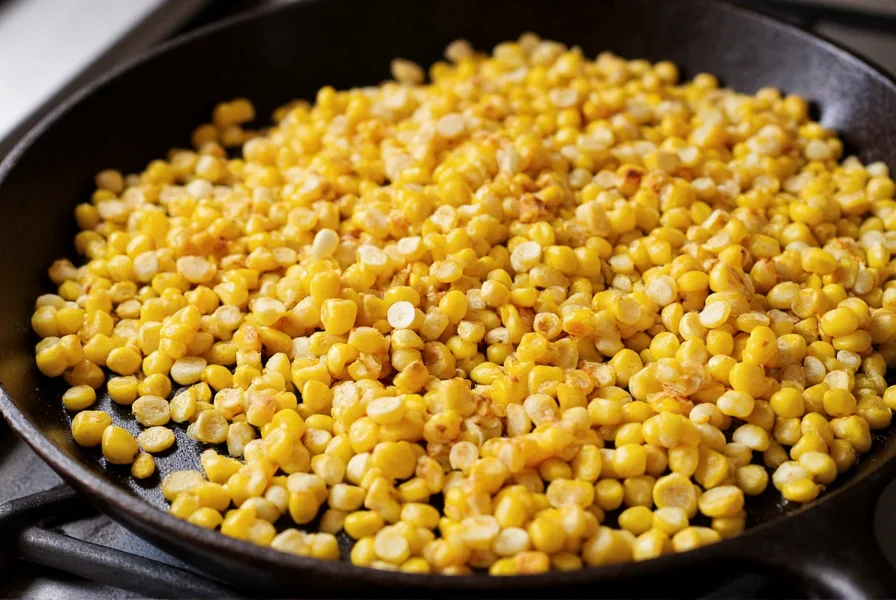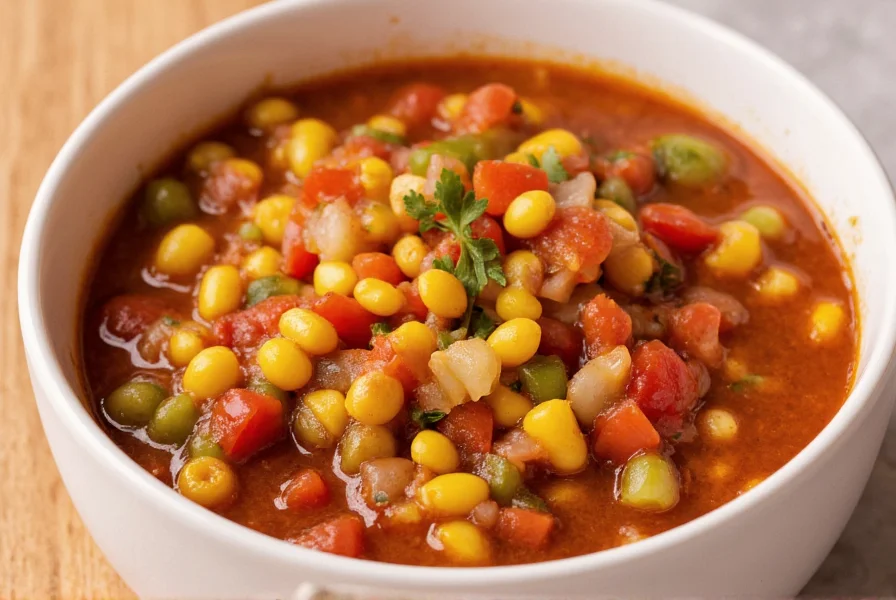Chili corn salsa has become a staple in modern Southwestern cuisine, offering a refreshing alternative to classic tomato salsas. This versatile dish combines the natural sweetness of corn with the heat of chili peppers, creating a flavor profile that complements everything from fish tacos to grilled chicken. Whether you're hosting a summer barbecue or looking for a quick weeknight side dish, understanding how to make authentic chili corn salsa can elevate your meal preparation significantly.
The Essential Components of Great Chili Corn Salsa
Creating exceptional chili corn salsa starts with selecting quality ingredients. While recipes vary by region and personal preference, certain elements remain consistent across authentic preparations.
Corn Selection and Preparation
The foundation of any good chili corn salsa is, naturally, the corn. You have several options:
- Fresh corn - Provides the sweetest flavor when in season (summer through early fall)
- Grilled corn - Adds a subtle smokiness that enhances the overall flavor profile
- Canned or frozen corn - Acceptable alternatives when fresh corn isn't available
For best results, remove corn kernels from the cob and either sauté briefly in a dry skillet for 3-4 minutes or grill for 5-7 minutes to develop caramelized notes. Allow to cool completely before mixing with other ingredients.

Chili Varieties and Heat Levels
The "chili" component gives this salsa its characteristic kick. Understanding your heat preferences helps determine which peppers to use:
| Chili Type | Heat Level (Scoville) | Flavor Profile | Recommended Amount |
|---|---|---|---|
| Jalapeño | 2,500-8,000 | Grassy, bright | 1-2 peppers, seeded |
| Serrano | 10,000-23,000 | Sharp, herbal | 1 pepper, seeded |
| Poblano | 1,000-2,000 | Earthy, mild | 1-2 peppers, roasted |
| Habanero | 100,000-350,000 | Fruity, intense | ¼-½ pepper, seeded |
For authentic homemade chili corn salsa without overpowering heat, jalapeños with seeds removed provide the ideal balance. Remember that smaller diced peppers distribute heat more evenly throughout the salsa.
Step-by-Step Preparation Guide
Creating restaurant-quality chili corn salsa at home requires attention to detail but remains remarkably simple. Follow these steps for consistent results:
Basic Recipe for Authentic Chili Corn Salsa
Makes approximately 4 cups | Prep time: 20 minutes | Resting time: 30+ minutes
Ingredients
- 2 cups fresh corn kernels (about 3-4 ears)
- 1 medium red bell pepper, finely diced
- 1 jalapeño pepper, seeds and membranes removed, finely diced
- ½ cup red onion, finely diced
- 1 cup cherry tomatoes, quartered
- ¼ cup fresh cilantro, chopped
- 3 tablespoons fresh lime juice
- 1 clove garlic, minced
- ½ teaspoon ground cumin
- Salt to taste (about ½ teaspoon)
Preparation Method
- Prepare corn by grilling or sautéing as described previously; cool completely
- In a large bowl, combine cooled corn with all remaining ingredients
- Gently fold ingredients together to avoid crushing the corn
- Cover and refrigerate for at least 30 minutes to allow flavors to meld
- Before serving, adjust seasoning with additional lime juice or salt as needed

Variations and Customizations
One reason chili corn salsa has gained popularity is its adaptability to different tastes and dietary needs. Consider these variations when preparing your next batch:
Regional Style Variations
Southwestern Style: Add ½ teaspoon smoked paprika and 2 tablespoons black beans for a heartier texture popular in New Mexico and Arizona.
Tropical Twist: Incorporate ½ cup diced mango or pineapple for a sweet contrast that works particularly well with fish tacos.
Chipotle Version: Substitute one jalapeño with 1-2 canned chipotle peppers in adobo sauce for a smoky depth of flavor.
Dietary Adaptations
Chili corn salsa is naturally gluten-free and vegan when prepared with the basic recipe. For those monitoring sodium intake, simply reduce or omit added salt and rely on the natural flavors of fresh ingredients. The sugar content remains low (approximately 6g per ¼ cup serving) when prepared without added sweeteners.
Serving Suggestions and Storage Tips
Understanding how to serve and store your chili corn salsa properly ensures optimal flavor and food safety.
Ideal Pairings
While excellent as a standalone dip with tortilla chips, chili corn salsa shines when paired with specific dishes:
- Grilled fish or shrimp tacos
- Black bean burgers
- Roasted vegetable wraps
- As a topping for grilled chicken or pork
- Mixed into cooked quinoa or rice for a flavorful side dish
Storage Guidelines
Properly stored in an airtight container, fresh chili corn salsa maintains quality for 3-4 days in the refrigerator. The flavors often improve after 24 hours as ingredients continue to meld. Do not freeze traditional corn salsa as the texture of fresh vegetables deteriorates significantly upon thawing.
Common Mistakes to Avoid
Even simple recipes can go wrong without proper technique. Watch for these common pitfalls when preparing chili corn salsa:
- Using warm corn - Adding corn while still warm causes tomatoes to break down prematurely
- Over-processing - Pulse blending creates an undesirable texture; hand-chopped ingredients maintain better texture
- Insufficient resting time - Flavors need at least 30 minutes to properly meld
- Incorrect acid balance - Too little lime juice makes salsa taste flat; too much overwhelms other flavors
- Improper chili handling - Always wear gloves when handling hot peppers and avoid touching your face
Frequently Asked Questions
Can I use frozen corn for chili corn salsa?
Yes, frozen corn works well for chili corn salsa when fresh corn isn't available. Thaw completely and pat dry with paper towels to remove excess moisture before using. For best flavor, sauté thawed corn in a dry skillet for 3-4 minutes to develop caramelization before cooling and adding to your salsa mixture.
How can I make my chili corn salsa less spicy?
To reduce spiciness in chili corn salsa, remove all seeds and white membranes from chili peppers (where most capsaicin resides), use milder peppers like poblano instead of jalapeño, and increase the ratio of sweet ingredients like corn and bell peppers. Adding 1-2 tablespoons of honey or agave syrup can also balance heat, though traditional recipes avoid added sweeteners.
What's the difference between chili corn salsa and regular salsa?
Chili corn salsa features corn as the primary ingredient rather than tomatoes, creating a sweeter flavor profile with textural contrast from the corn kernels. While traditional salsa relies on tomatoes as the base with supporting vegetables, chili corn salsa reverses this relationship. The preparation method also differs, as corn typically requires pre-cooking (grilling or sautéing) before incorporation, whereas tomatoes in regular salsa are usually used raw.
How long does homemade chili corn salsa last in the refrigerator?
Properly stored in an airtight container, homemade chili corn salsa maintains optimal quality for 3-4 days in the refrigerator. The flavors often improve after 24 hours as ingredients continue to meld. Discard if you notice any off odors, significant discoloration, or mold growth. Do not freeze traditional corn salsa as the texture of fresh vegetables deteriorates significantly upon thawing.











 浙公网安备
33010002000092号
浙公网安备
33010002000092号 浙B2-20120091-4
浙B2-20120091-4